Rosafresca’s Instruments
A medley of Instruments
Early instruments seldom match the dynamic range of their modern orchestral equivalents, but they do have a range of expression which, at its best, gives the music great emotional depth. Renaissance Spanish music provides many possibilities to contrast different instrumental families, such as the sensuous quality of recorders and voice against rhythmic bass lines played on viol, vihuela or cornamuse and driving percussion.
The instruments that we play are described on this page.
- Voice
Voice
The voice is not usually regarded as an instrument. In fact, the voice works like any other woodwind, with air passing over a vibrating membrane - the vocal cords. Pitch is changed by altering the cord tension, and the quality of the voice can also be varied by changing the shape of the mouth and tilting the larynx. Singing was highly regarded as a skill for both men and women. Queen Isabella was herself an accomplished singer, and taught her daughter Catherine of Aragon. History records that Catherine sang Spanish songs at the English court with her cousin Margaret of Austria, before her marriage to Henry VIII. We also know that the Spanish court was very aware of the wider European culture. Our main source book, 'The Songs of the Palace', includes pieces from the Netherlands to Southern Spain, which was in turn influenced by North African music. Expert singers may have employed a range of styles, including the reedy quality of the classical Arabic tradition, and the purity of early French song. - Vihuela
Vihuela
This is a very attractive instrument, looking like a small elegant guitar with an exquisite carved sound-hole based on the 'rose' windows of great Medieval cathedrals. There are five paired strings and a single top string, eleven in all, which take a great deal of tuning, usually accompanied by much swearing. The vihuela is unrelated to the guitar, but probably shares a common ancestry with the viol. The vihuela is a very versatile instrument. Played with individual finger technique, it can act as a sweet and delicate melody instrument or as a sympathetic support to a vocal line. It can also be strummed adding rhythmic drive to more lively pieces. There are at least five sizes of vihuela tuned to different pitches that are used to accompany the voice. The vihuela was only around for about 150 years, from 1450 to 1600, and was hardly known outside Spain. There is a considerable solo repertoire dating from around 1500 and a number of important composers, such as Luis de Milan, wrote methods on how to play the vihuela. By about 1650, it was superseded by the Baroque guitar - the early ancestor of the modern classical guitar. The designs for modern instruments have been reconstructed from the remaining fragments of ancient instruments, pictures and engravings in guitar methods, and even church carvings where angels were often depicted playing musical instruments.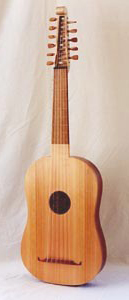 With thanks to: George Stevens
With thanks to: George Stevens - Viola da gamba
Viola da gamba
The viol da gamba or viol appeared in Europe, probably from North Africa via Spain in the mid fifteenth century. It became one of the most popular instruments of the Renaissance and Baroque, much used in ensemble music involving three to six instruments. The baroque viol differs from the renaissance model in being more substantially constructed and has both sound post and bass bar, creating a larger sound. The last music written for the viol before its modern revival was in the 1680's by Henry Purcell. The viols are more like the vihuela than their modern string counterparts, as they have gut frets and are tuned in fourths with a central third. The treble is played on the lap and the tenor and bass between the legs. Unlike the cello, the bass viol has no spike. Like lutes, they were often played by amateurs and large wealthy homes often had a chest of viols containing the different sized instruments. The treble and tenor instruments died out in the seventeenth century, although the bass survived much longer, appearing in the church bands of Thomas Hardy's novels. A contrabass instrument called a violone developed into our modern double bass. The instruments were revived in the 1930's primarily due to the efforts of the Dolmetsch family and its popularity has increased since that time. Originally, the viol was prized for its plaintive sound, which complements the human voice. However, as with the vihuela, it can be used in a more percussive way by plucking the strings or striking them with a bow.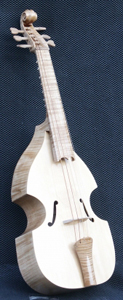 Tenor viol made by: Richard Jones
Tenor viol made by: Richard Jones - Recorder
Recorder
Folk instruments of similar construction to the recorder are played all over the world, the oldest being an instrument from China that is at least 3000 years old. The Renaissance was the high point for the recorder, with many of Shakespeare's plays calling for 'still music', a specific reference to the instrument, especially at moments of religious significance. The recorder decreased in popularity during the seventeenth century, apart from the treble that survived as a Baroque solo instrument, most notably in Bach's Brandenburg concertos. The modern revival has produced a wealth of new compositions, including pieces by Hindemith and Henze. Although the recorder is a simple instrument, it is not easy to play well - as Hamlet noted rather sarcastically. There are inherent tuning problems requiring the use of alternative fingerings and shadings, and each instrument has a slightly different scale that demands careful listening from the player. The recorder is also very sensitive to breath pressure. We use a range of instruments to match the needs of the music. The Renaissance instruments pictured here have a wider bore, larger finger holes and produce a more reedy and penetrating quality than their Baroque counterparts.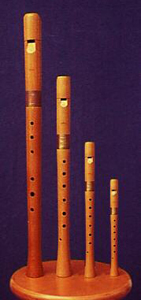 Renaissance recorders: Moeck
Renaissance recorders: Moeck - Cornamuse
Cornamuse
The cornamusen are woodwind of the 'windcap' variety. The sound, a bit like a loud kazoo, is produced by a double reed within a wooden cap and, like the recorder, similar double reed instruments are found in cultures across the world. There's some confusion about the type of music these instruments would play, as the word conamusa also refers to the bagpipe of the time. As with the recorder, cornamusen can also be played in consort, coming in five sizes and producing a rich and reedy sound. This arrangement was probably used in the 'loud bands' popular for major Renaissance entertainments, as contrasted with the softer recorder band. Unlike recorders, cornamusen use very little breath at very high pressure. Players have to work hard to keep a good seal around the mouthpiece and keep the tuning under control.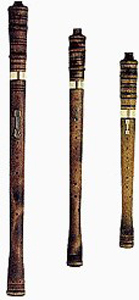 Cornamuse from: Moeck
Cornamuse from: Moeck - Percussion
Percussion
Again, we know little about what instruments were used, especially as percussion is almost never specified outside the orchestral tradition. So it's one of the joys of this music that we've been able to explore both European and Arabic percussion, adding great variety and drive to the music. At present, our percussion includes:Frame drums (top) - large shallow drums from 30-60 cm in diameter that produce a very resonant sound and can be tuned to the mode of the piece. The darabuka (second) - a one- or two-headed drum of relatively high pitch, usually with a ceramic, wooden or metal body. The riqq (third) - a small frame drum with jingling-plates from North Africa that has existed in Spain from the Middle Ages to the present day under the name of pandereta. The tabor (bottom) - a large cylindrical drum played with a single stick. For more information about tabors, see Harms Historical Percussion. We also use folk percussion such as claves, maracas and bells. The darabuka, frame drums and riqq were made for us by Norbert Eckermann.
- Lute
Lute
[caption id="attachment_502" align="alignright" width="154"]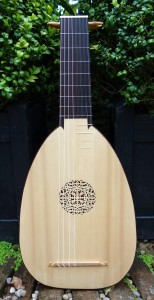 Renaissance lute by Arthur Robb 2013[/caption]
The lute has a long and distinguished history, the origins of which can be traced to Mesopotamia from 3000 BC. When the Moors invaded Spain in the eighth century, they brought with them a plucked instrument called the oud (literally meaning 'the wood'), which has the typical lute pear-shaped body with bowled back and angled peg box. The earliest depiction of a European lute can be found in the Libro de Jueglos (Book of Games) commissioned by Alphonso in 1283. This instrument is fretted, whilst the oud is not, reflecting the very different type of music played by the two traditions.
The earliest European lutes have four courses or pairs of strings. Over time, these increased to five, and then six - which became the standard number for most of the Renaissance. It was only in the second half of the sixteenth century that the number of courses increased to ten. During the baroque period, the body size and number of strings increased with up to 14 courses being common. This caused certain tuning difficulties and was one of the reasons for the demise of the lute in the eighteenth century. Another reason was its small volume compared to keyboard instruments, which were more effective in providing accompaniment and continue parts in chamber ensembles.
When asked how long he had been playing, the great lutenist, Sylvius Leopold Weiss - then in his fiftieth year, answered "Twenty years". Contradicted by one of his friends, who knew for certain that Weiss was already playing the lute in his tenth year, Weiss replied, "True, but for twenty years I was tuning the instrument".
Renaissance lute by Arthur Robb 2013[/caption]
The lute has a long and distinguished history, the origins of which can be traced to Mesopotamia from 3000 BC. When the Moors invaded Spain in the eighth century, they brought with them a plucked instrument called the oud (literally meaning 'the wood'), which has the typical lute pear-shaped body with bowled back and angled peg box. The earliest depiction of a European lute can be found in the Libro de Jueglos (Book of Games) commissioned by Alphonso in 1283. This instrument is fretted, whilst the oud is not, reflecting the very different type of music played by the two traditions.
The earliest European lutes have four courses or pairs of strings. Over time, these increased to five, and then six - which became the standard number for most of the Renaissance. It was only in the second half of the sixteenth century that the number of courses increased to ten. During the baroque period, the body size and number of strings increased with up to 14 courses being common. This caused certain tuning difficulties and was one of the reasons for the demise of the lute in the eighteenth century. Another reason was its small volume compared to keyboard instruments, which were more effective in providing accompaniment and continue parts in chamber ensembles.
When asked how long he had been playing, the great lutenist, Sylvius Leopold Weiss - then in his fiftieth year, answered "Twenty years". Contradicted by one of his friends, who knew for certain that Weiss was already playing the lute in his tenth year, Weiss replied, "True, but for twenty years I was tuning the instrument".